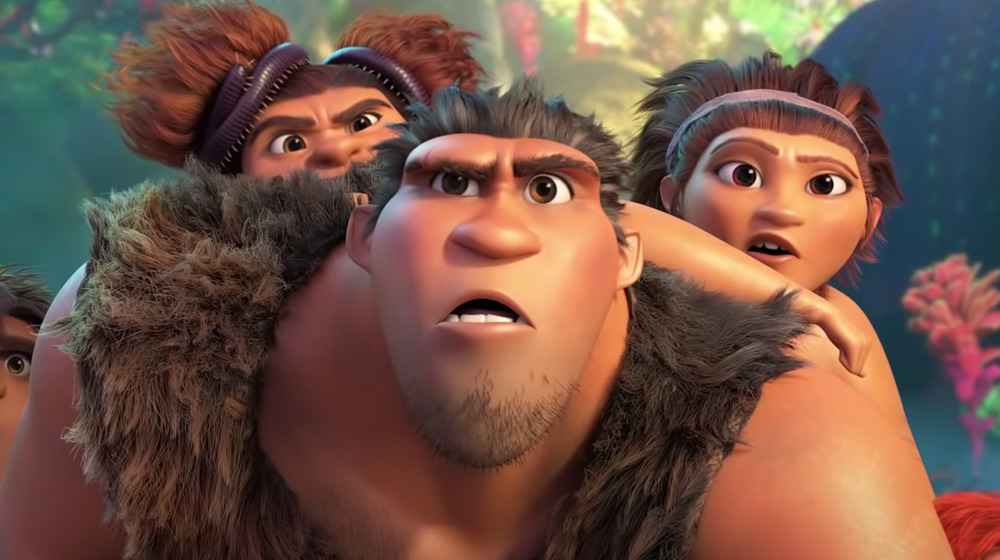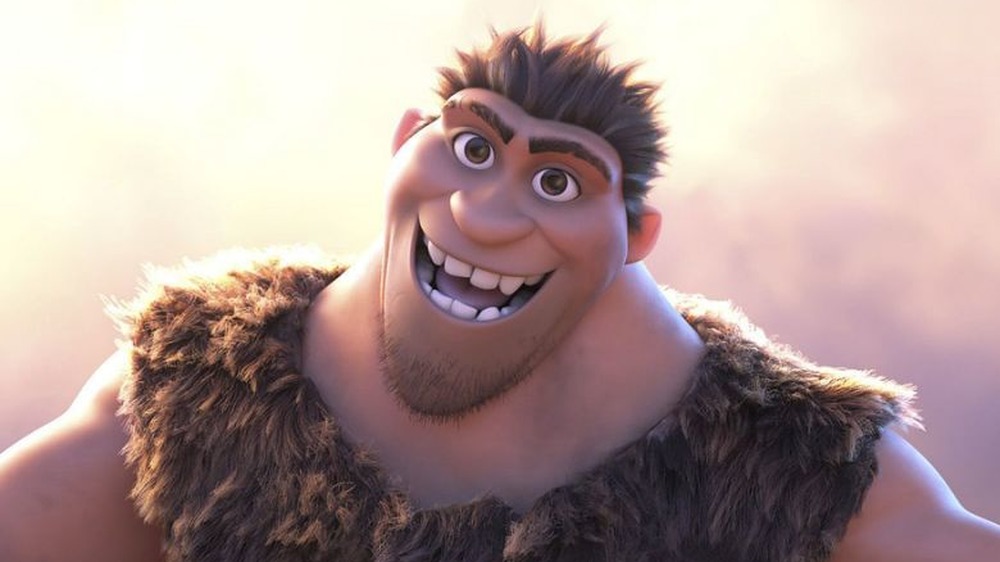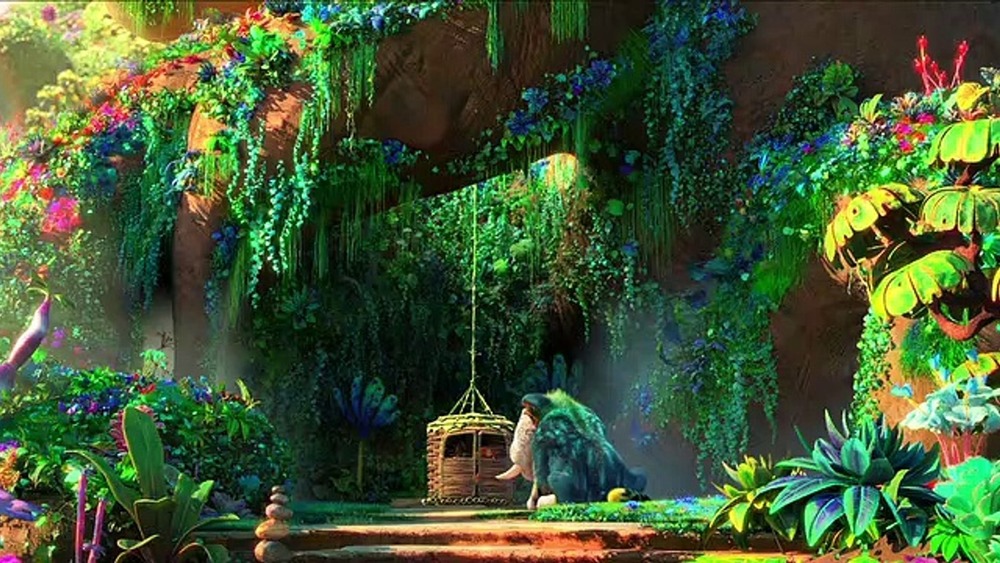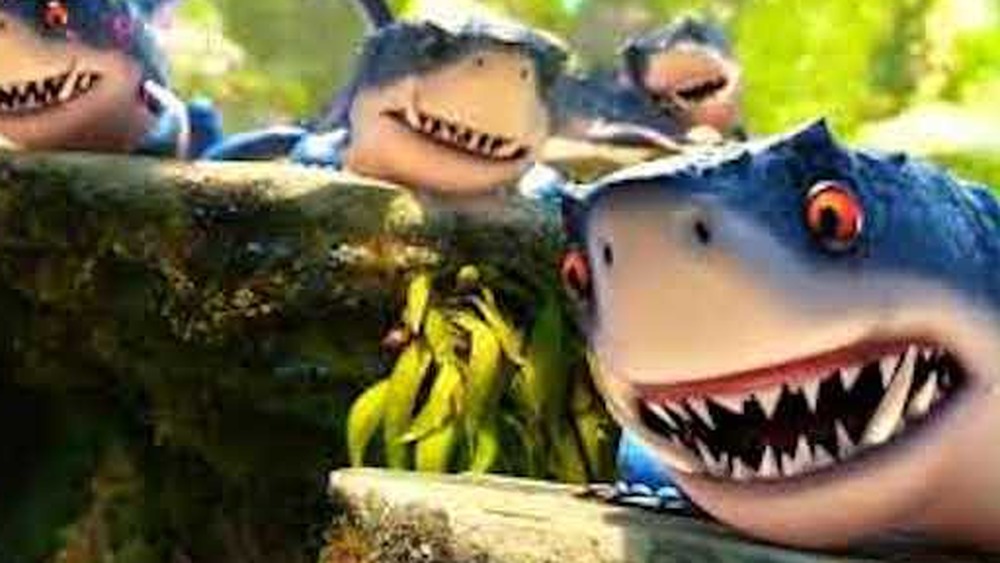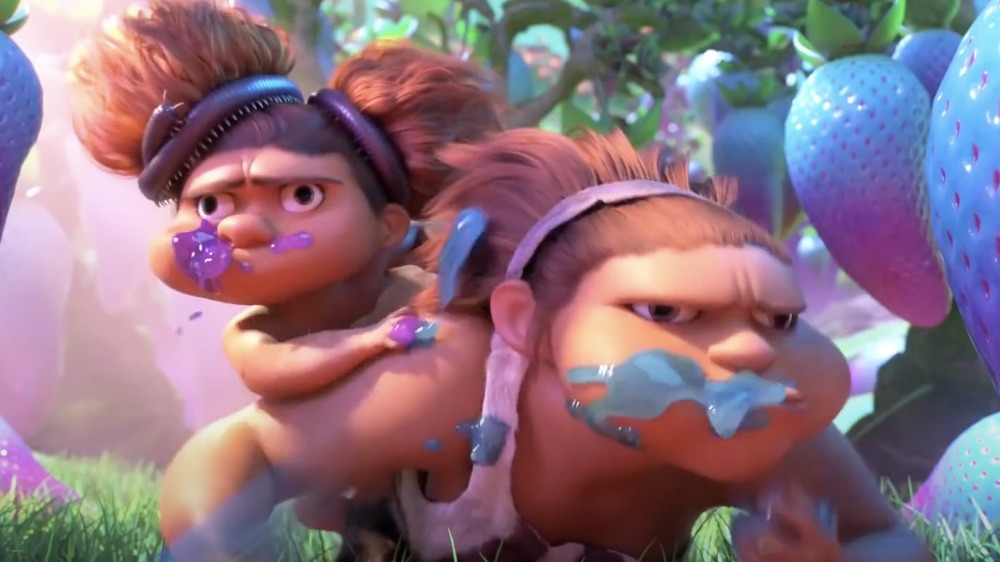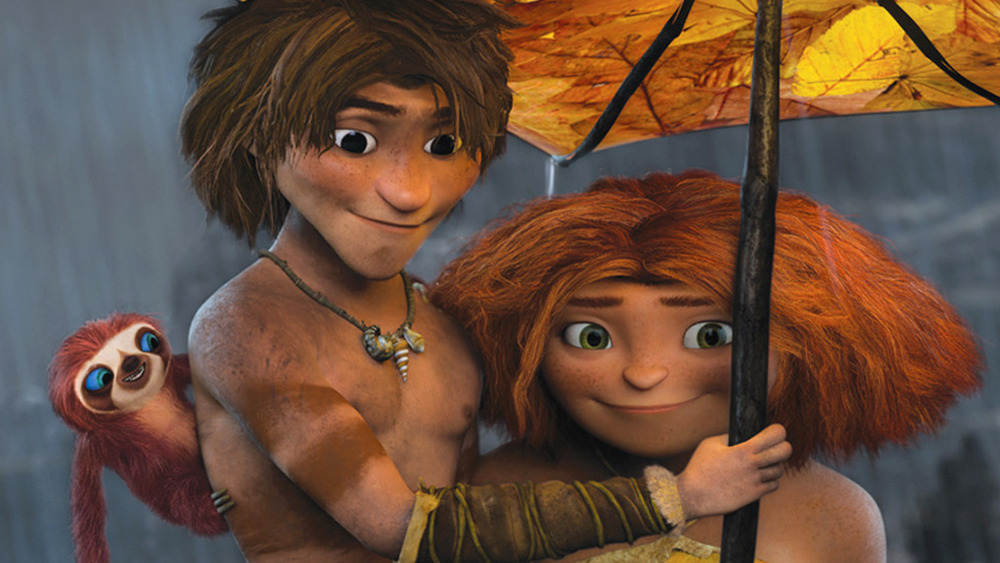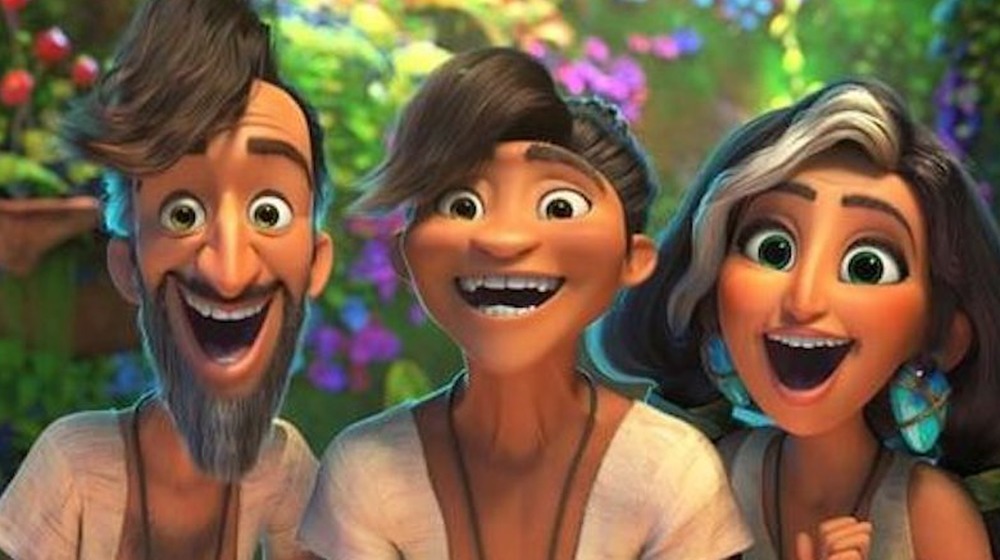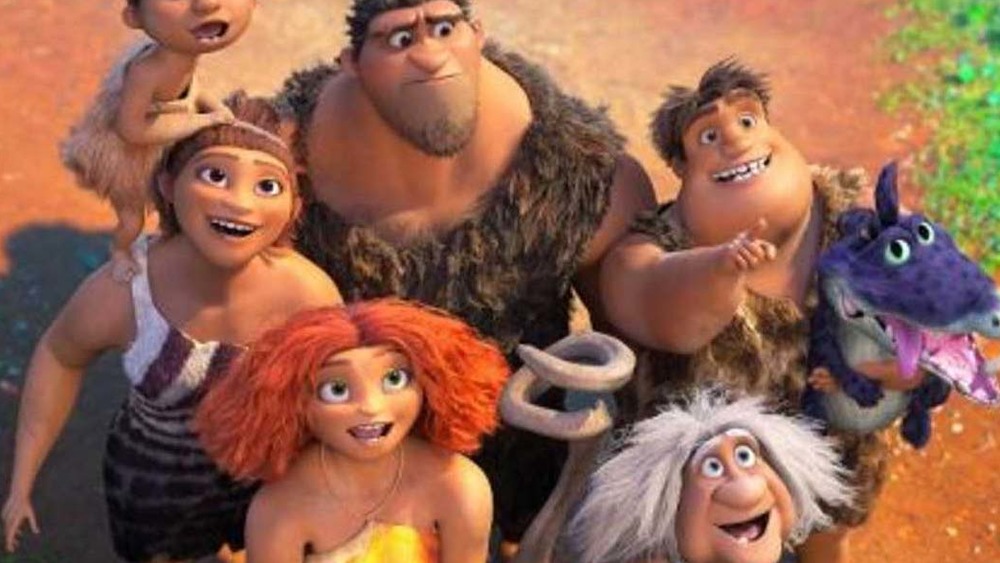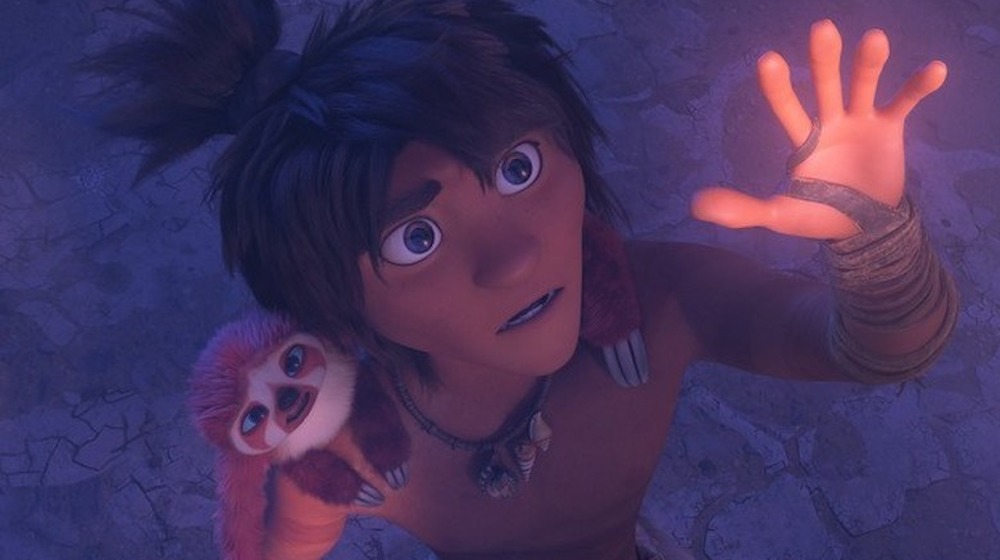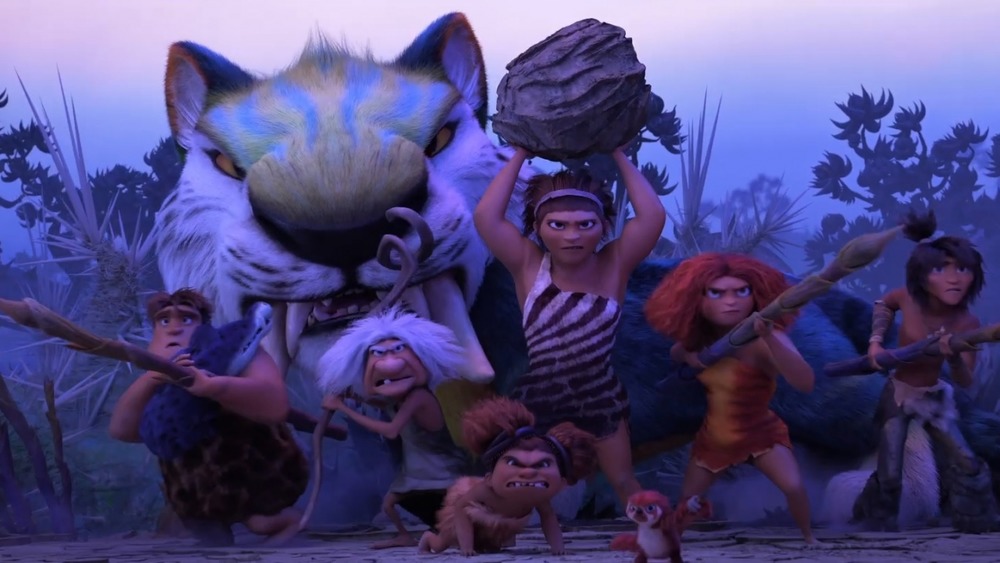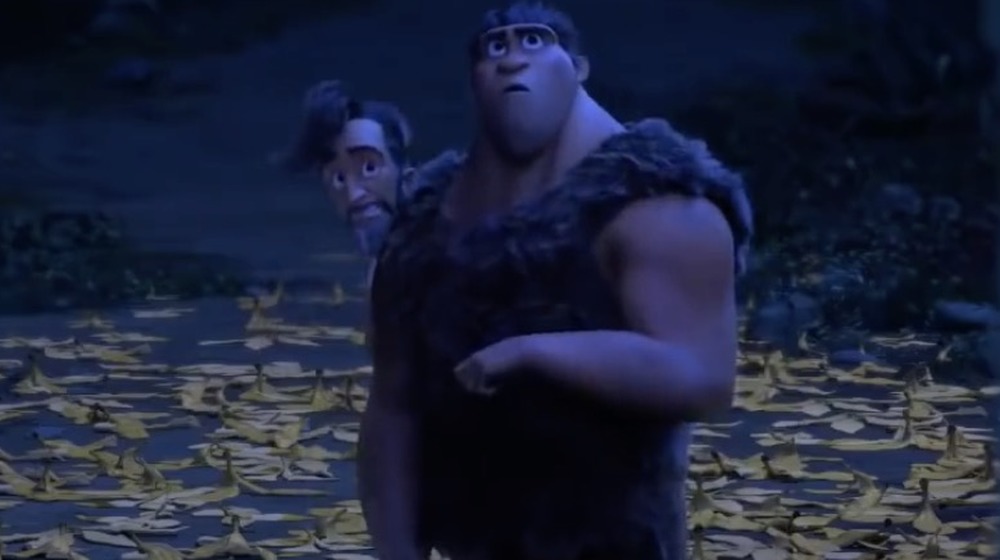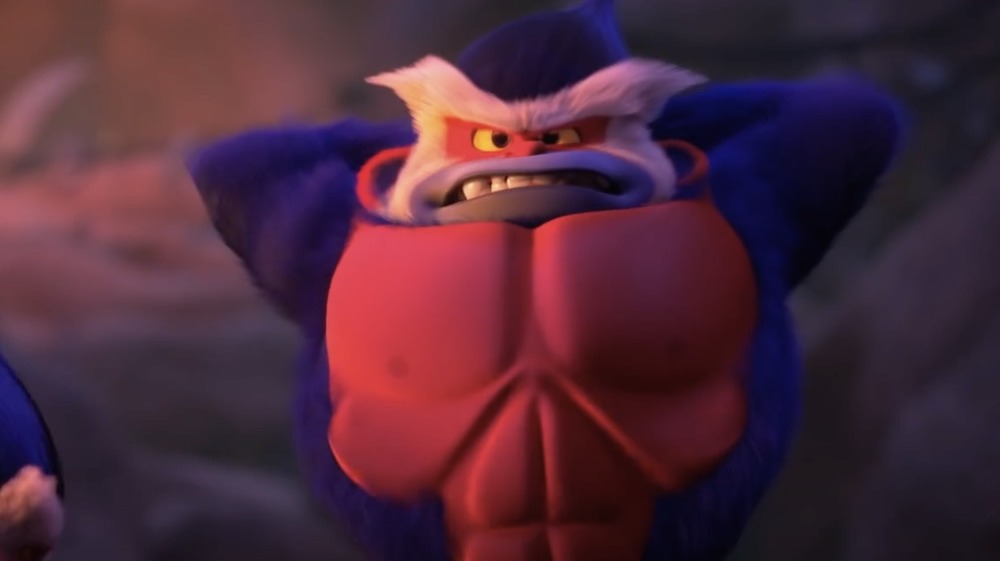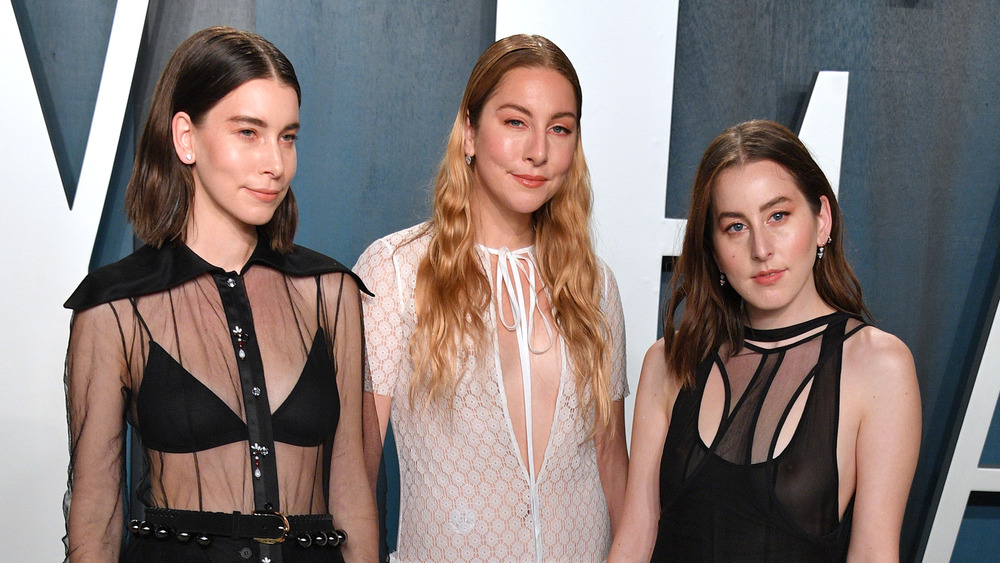Things Only Adults Notice In The Croods: A New Age
In late 2020, The Croods: A New Age finally hit theaters and streaming platforms, seeking to entertain toddlers and elementary school-age kids with the antics of the Croods, a family of prehistoric porto-humans. Its predecessor, The Croods, was a box office smash upon its release in 2013 and earned an Oscar nomination for Best Animated Feature, but getting the next movie made took years, and DreamWorks even canceled production at one point. That makes both children and adult fans of The Croods all the more ready to explore the titular collective's continuing adventures. In A New Age, these denizens of the past head kicking and screaming into the future as they variously explore new romantic entanglements, tenuous friendships, and encroaching technology.
As is often the case with kid-friendly movies, The Croods: A New Age is loaded with jokes, references, and storylines that younger viewers won't notice, threaded throughout to keep the parents in the audience paying attention and interested. Here are some things in the new Croods sequel that only older viewers will understand and enjoy.
The movie explores complicated parenting issues
The Croods: A New Age is all about the Crood collective attempting to embrace a newer, easier, and potentially more civilized kind of life, despite their reservations about how all the new technology — and Hope and Phil Betterman's smug attitude about it — could create distance between them. This is a theme many adult viewers of The Croods: A New Age may be quite familiar with in their lives as they parent in the Information Age — debating how best to manage their kids' screen time or if they should allow them to have smartphones or social media accounts, for example. Grug and Ugga face these same questions of whether to be prehistoric helicopter parents or proto-free range parents, just with different technology.
The Croods: A New Age also delves into another complex emotional issue relatable only to those who have left home or raised kids already. Grug is very close with his teenage daughter, Eep, and he experiences major anxiety as she pulls away from childhood — and him being the major male figure in her life — and into adulthood, as she falls in love with Guy. He gets even more worried when he thinks about the inevitability of Eep and Guy leaving their group to go start their own pack. That actually happens at the end of the movie, although the credits roll before viewers get a chance to witness Grug develop "Empty Nest Syndrome."
The Bettermans might be the smartest people who ever lived
Kids watching The Croods: A New Age will recognize Hope and Phil Betterman for what they are: a snooty, sanctimonious couple who look down their noses on those they consider less civilized or socially evolved (which in this case is the Crood family). Adults, however, will notice that the Bettermans can pretty much back up their passive-aggressive posturing because they've invented numerous pieces of earth-changing technology.
Hope and Phil are innovators on the level of Leonardo Da Vinci or Thomas Edison. So much of the action of The Croods: A New Age takes place at their palatial treehouse, which they built themselves, seemingly right after inventing the idea of architecture. It's outfitted with flushing toilets and showers, indicating the Bettermans came up with a sophisticated indoor plumbing system, which likely uses some of the same water utilized by the couple's extensive irrigation network. After all, they turned a section of barren wasteland into a lush oasis where a wide variety of edible crops can thrive. Impressed grown-up viewers may also figure out that the Bettermans did all of their inventing in a remarkably short period, a great leap forward of ingenuity and engineering entirely between the time they last saw little boy Guy, and when he came back into their lives as a teenager.
The pop culture references don't register with young viewers
The Croods: A New Age is a DreamWorks production, and like its studio sibling Shrek and its sequels, it's laced with references to well-known movies. The prehistoric comedy also features a lot of out-of-time, anachronistic nods to TV shows, video games, and other bits of pop culture — none of which the average grade-school age Croods viewer is likely to notice or understand.
Much of the action takes place in and around the Bettermans' jungle compound, the centerpiece of which is a sprawling, multi-level, multi-room, well-appointed treehouse — much like the one in the 1960 Disney classic Swiss Family Robinson. When young Crood kid Clark Duke makes himself at home at the Bettermans' home, he's almost immediately hypnotized by "Window," a literal window that's supposed to resemble a giant TV screen. He gets addicted to watching the action outside, which he calls "Birds," and this semblance of a show looks a lot like Angry Birds, the smartphone game older kids and their parents grew obsessed with a few years back. Going even farther back: "land sharks" are said to stalk the lands around the sanctuary — evoking a series of Jaws parody sketches from Saturday Night Live in the '70s, which found the movie's titular shark gaining entry into homes. Today's kids probably don't have a familiarity with early SNL.
There's a lot of boozing and drugging in The Croods: A New Age
Kids aren't likely to notice when a movie, let alone a silly animated movie, makes a subtle, declarative statement about human nature. Older viewers just might notice that The Croods: A New Age suggests that human beings — even prehistoric, early ones born thousands of years ago — possess a want, if not a pathological need, for a chemically-induced head change. Basically, there's a lot of implied alcohol and drug consumption in The Croods: A New Age, or at least some frequent use of caveman corollaries for modern-day casual intoxicants. After they get behind the safe walls of the Betterman homestead, the adult Croods need a little social lubricant in the form of shark milk; they drink it like it's beer or wine.
While Grug is never shown getting all-out drunk on shark milk, he is depicted in a state of inebriation reminiscent of the acid-trip animation of Yellow Submarine. Before the Croods discover the Bettermans, they discover their vast reserves of ripe, on-the-vine produce and eat fruit until they're in a blissful, euphoric state. One character that does seem drunk, however, is teenager Dawn, who gets loud, wacky, and obnoxious after she has a bad reaction to some bee venom.
Yabba-dabba Croods
Apart from a culture clash between the Croods and the Bettermans over and amidst their utopian jungle paradise, the central plot of The Croods: A New Age concerns the romance between teenagers Eep and Guy. Overlooking the weird, uncomfortable, and noticeable-to-adults fact that Guy is Eep's adoptive brother, theirs is a sweet romance that captures those giddy feelings of young love. There are also subtle jokes for the benefit of older viewers for whom that first relationship is well past them — for example, a smitten Eep quips, "We're the only two teenagers in the world. It's like fate brought us together!"
Eep and Guy may remind adults of their own overwhelming first love experiences, but the couple may also remind grown-ups of another, relatively ancient pop culture couple. Eep has red hair, Guy is a muscular type who wields a blunt weapon, and they're together more out of proximity than anything else. That's just like Pebbles and Bam-Bam of The Flintstones. Those two — she with the red hair, he with the club — eventually wind up a couple after years of living next door to each other in Bedrock, a place right out of pre-history, much like the world of The Croods.
It mocks the absurdities of 21st century life
Speaking of The Flintstones, it seems like the whole point of making a historical comedy is to draw parallels between the long ago and the here and now — and to point out the inherent silliness in everyday, modern-day items and conveniences. Implying that the more things change the more they remain the same is a gentle form of satirical humor — it's all over The Croods: A New Age, and only older viewers can truly appreciate it.
For example, it's perfectly normal for today's adults to drink coffee, but when prehistoric people do it in The Croods: A New Age, they amusingly call it exactly what it is: "fresh bitter bean juice." When the Bettermans work over Guy to make him seem more civilized, they allow him to take what it's implied to be a shower, and afterward he's said to smell like "a clear mountain stream with just a hint of vanilla" — meaning he used a historical equivalent of modern-day, profusely described body wash. And finally, when Ugga gets a glimpse of the Bettermans' toilet, she remarks that Grug "spends a lot of time in there." It would seem that dads have always stereotypically spent a lot of time in the bathroom.
The names are baffling
The naming conventions of The Croods: A New Age are accepted by kid viewers, but might be a little harder for the more naturally analytical adults in the audience to comprehend. The big problem is that they're maddeningly and confusingly inconsistent. Some of the characters carry typically "caveman"-type names that sound like grunts and guttural noises. Most members of the more primitive Crood family adhere to this idea, such as Grug, Eep, Ugga, and Thunk. But then, for some reason, the grandmother character sports the very modern affectionate nickname Gran, while the youngest Crood is named Sandy, which could be a reference to rocks and soil or just a 21st century kind of moniker. Stranger still: the family pet gets the longest, fanciest, and most evolved name of all: Douglas.
Going along with their caveman names is the last name of Crood, a modern idea, and it's one shared with rival family the Bettermans, whose name is a sly comment about their arrogance at having made themselves more civilized. Rounding out the odd names: the teenage male character, a guy, in other words, is literally named Guy. That just seems lazy.
White actors voice non-white characters, and that could be controversial
Over the last few years, Hollywood has responded to calls for better cultural and racial representation in entertainment. Animated series, including The Simpsons and Big Mouth, have opted to re-cast white performers who played African-American and biracial characters with voice actors of color. The characters in The Croods: A New Age are not white — the film presumably takes place where human beings first emerged, in Asia or Africa, and the skin color of Grug, Eep, Guy, and others reflects that. Adults aware of the move toward representation are also more likely to notice that several of the actors who portray these characters of color are of a white background. In keeping the cast of recognizable voices intact from the first Croods movie, producers rehired Nicolas Cage, Emma Stone, and Ryan Reynolds, for example. The Croods: A New Age doesn't align with Hollywood's progressive action, and that's clear to more mature viewers.
The Croods really know how to defend themselves
There's a lot going on, both on the surface and below it, when the Crood family goes into its battle-ready fight mode in The Croods: A New Age. When danger (or edible prey) approaches, it's Ooga who signals the call to action, yelling out for her brood to form a "kill circle." First of all, that's some surprisingly frank talk from a children's movie that tends to soften and downplay the darker aspects of its characters' lives, such as their needs to hunt for food and protect themselves against wild animals. Additionally, young viewers will likely get caught up in the stone-faced theatrics and weapon-hoisting of the Croods assembling into place that they'll miss the fact that the family doesn't even form a "kill circle" at all — they stand around in a couple of lines.
A couple of kill circle-adjacent quips nod toward the present-day issue of gun control. As the group stands around, ready to use their weapons, Eep reminds Guy to take off the "safety" on his weapon — it's not a gun, but a large stick, so the safety device here is a coconut. Ooga also tells her family to "never apologize for an effective kill circle," reminiscent of individuals who exercise their right to "stand their ground" and defend their property with the use of firearms.
Grug's avoidance of bananas reaches biblical proportions
For most of the running time of The Croods: A New Age, viewers are left to ponder the mystery of why the egregiously friendly and passive-aggressive Bettermans share absolutely everything in their compound with the Croods, especially food, but expressly forbid patriarch Grug from touching, eating, or going anywhere near their many piles of bananas. The fruit is abundant, and Grug's stated most pleasant memory is of that one time he ate one. Still, Phil Betterman announces his one and only "house rule": Don't eat the bananas. He doesn't offer an explanation until the film's storyline eventually clears things up, but before then, in The Croods: A New Age, bananas are quite literally the "forbidden fruit," a reference to the story of Adam and Eve from the Bible, who, like Grug Crood, jeopardized their life in paradise (the Garden of Eden, not the Betterman estate) because they ate the one thing they were explicitly told to avoid.
There are scientific implications of the punch monkeys
The Bettermans' garden may remind The Croods: A New Age viewers of the Garden of Eden, home to the biblical Adam and Eve. Many creationists believe that they were the first people on Earth, which stands in opposition somewhat to the worldview of evolutionists, who point to scientific events that humans descend from a primate ancestor. Many scientists have spoken of a so-called "missing link" along the line that would definitively connect ancient humans to ancient primates, and The Croods: A New Age alludes to this advanced, adult-centric scientific concept. The Croods and the Bettermans meet a race of monkeys of such advanced intelligence that they have a language. That language is punching, which is why they're called "punch monkeys," but it's also one that the human characters can quickly learn. It might occur to older Croods watchers that these extremely person-like punch monkeys just might represent that missing link in the evolutionary line.
The music is strictly for the adults
The soundtrack for The Croods: A New Age is loaded with familiar songs, and none of them seem to be for the benefit of the young viewers at whom the film itself is targeted. The opening bars of Spandau Ballet's synth-pop soft rock anthem "True" are repeatedly used as a love theme to underscore Eep and Guy's burgeoning romance — that song came out in 1982 and was a standard at countless proms and dances for parents watching The Croods, but will be largely unfamiliar to young viewers. It's a similar story for "I Think I Love You," the exuberant song of puppy love sung by teen idol David Cassidy in 1970, and used in The Croods to suggest Eep and Guy's romantic feelings. Kids won't know that song, and they certainly won't care about the reprise of it over the end credits by Jack Black in his fully unleashed Tenacious D rock star persona.
There's one major original song in The Croods: A New Age, and that's "Sisters of Rage," by alternative rock critics' favorites Haim. It's a blatant and obvious tribute to Guns N' Roses' "Welcome to the Jungle." This new tune is so similar to the '80s standard that parents watching the film may wonder if Haim was hired simply because producers couldn't get the rights to the GNR song.
